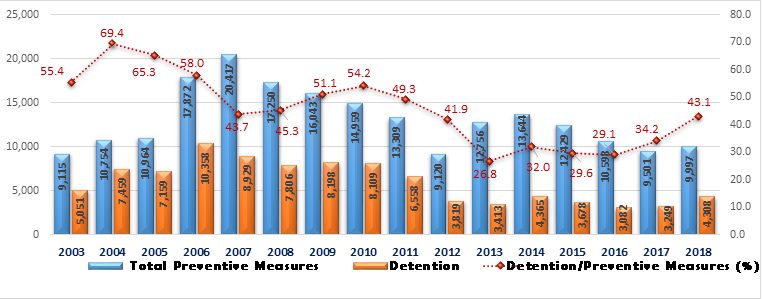Resume: Bidzina Ivanishvili does not specify the period or indicator to which he is referring. Based on indicators and different periods in our analysis, there is not a single case of a three-fold decrease in the number of pre-trial detentions.
If we take the detaining to preventive measures ratio as a share of pre-trial detentions, we will see that the 2018 figure (43.1%) is in fact higher as compared to the 2012 figure (41.9%) by 1.2 percentage points instead of being lower. In regard to a comparison of six-year periods, the average figure under the Georgian Dream’s rule (32.5%) is only 1.5 times less than the same figure (47.6%) of the same period under the United National Movement’s rule.
In addition, the number of approvals of the courts vis-à-vis a prosecutor’s motion to detain a suspect decreased 1.2 times in 2018 as compared to 2012. Of note is that the highest figure under the Georgian Dream’s rule was registered in 2018 (74.5%). In regard to the average figures in the six-year period of the Georgian Dream’s rule (93.6% in 2007-2012 and 65.5% in 2013-2016), it decreased 1.4 times as compared to the same period under the previous government.
Of note is that as compared to the previous government’s rule, the amount of detentions does indeed decline in numbers. However, it is incorrect to flaunt absolute figures alone. In addition, the decrease in both absolute and relative numbers starts from 2011. Therefore, it is difficult to determine which specific reform should claim credit for decreasing these figures.
Analysis
The Chair of the Georgian Dream, Bidzina Ivanishvili, presented the public his own assessment of the progress vis-à-vis the judiciary using different statistical data. Mr Ivanishvili stressed the decrease in the number of rulings of detention as a preventive measure. As he stated (39th minute): “The number of pre-trial detentions decreased three-fold.”
FactCheck took interest in the accuracy of the statement.
In accordance with Georgian legislation and international practice, pre-trial detention is considered as one of most severe forms of preventive measures. In accordance with Article 205 of the Criminal Procedure Code of Georgia, detention as a preventive measure is applied if it is the only instrument to prevent a suspect from absconding or from his attempting to prevent justice or the obtaining evidence, or if there is a risk of his committing a new crime.
When we use data about pre-trial detention as a measure against the independence of the judiciary and the judiciary’s “liberation from the pincers of the prosecutor’s office,” the pre-trial application figure (meaning the share of detention in preventive measures in court decisions throughout the years) and the figure of the court’s approval of a prosecutor’s motion about the application of pre-trial detention are both of interest. However, it is also possible that these data will not be sufficient to provide an accurate picture. In particular, it is not excluded that an increase/decrease in court approvals to a prosecutor’s motion about pre-trial detention is stipulated by improvements/deterioration in the work of the prosecutor’s office or by any other objective circumstances and not by improvements in the judiciary.
In accordance with the data that the Supreme Court of Georgia provided to FactCheck, the amount of times a court approved a prosecutor’s motion about the application of pre-trial detention was quite high under the previous government. Since 2012, however, it has started to decrease. The most evident decrease was registered in the period of 2012-2013. Of note is that the sharp drop in a court approving a prosecutor’s motion to apply pre-trial detention in 2013-2014 was largely stipulated by leaving the motions without discussion because of plea bargains (see Table 1). However, of additional note is that as compared to the previous years, the court’s rejection of a prosecutor’s motions and the application of milder forms of preventive measures also increased noticeably in this period (and in the following years).
Table 1: Number of Prosecutor’s Office Motions about Pre-Trial Detentions and Share of Rejections (%)
|
Motion for Detention |
Approval (%) |
Rejection to Detain and Application of other Measure (%) |
Left without Discussion because of Plea Bargain (%) |
Rejection to Apply a Preventive Measure (%) |
|
|
2007 |
9,559 |
93.4 |
6.1 |
0.4 |
0.1 |
|
2008 |
8,197 |
95.2 |
4.4 |
0.3 |
0.1 |
|
2009 |
8,713 |
94.1 |
3.2 |
2.6 |
0.1 |
|
2010 |
8,761 |
92.6 |
0.9 |
6.5 |
0.0 |
|
2011 |
6,948 |
94.4 |
0.1 |
5.5 |
0.0 |
|
2012 |
4,154 |
91.9 |
2.8 |
5.1 |
0.1 |
|
2013 |
5,222 |
65.4 |
9.0 |
24.0 |
1.6 |
|
2014 |
7,176 |
60.8 |
7.9 |
28.7 |
2.6 |
|
2015 |
6,196 |
59.4 |
34.5 |
4.7 |
1.5 |
|
2016 |
5,044 |
61.1 |
33.3 |
4.5 |
1.1 |
|
2017 |
4,506 |
72.1 |
23.1 |
4.2 |
0.6 |
|
2018 |
5,784 |
74.5 |
21.6 |
3.7 |
0.2 |
Source: Supreme Court of Georgia
From 2016, the number of approval motions on pre-trial detentions is growing again. The highest figure under the Georgian Dream’s rule (74.5%) was registered in 2018.
Graph 1: Number of Prosecutor Office Motions to First Instance Courts to Apply Detention as a Preventive Measure and Number of Court Approval of Those Motions in 2003-2017 (%)

Source: Supreme Court of Georgia
As illustrated by the graph, the number of motion approvals decreased 1.2 times in 2018 as compared to 2012. In regard to the average figure for the six-year period of the Georgian Dream’s rule as compared to the same figure of the same period for the previous government (93.6% in 2007-2012 and 65.5% in 2013-2016), it decreased 1.4 times.
In accordance with the data provided to FactCheck by the Supreme Court of Georgia, the number of applications of pre-trial detention under the previous government was quite high. Since 2010, however, it has a trend of decrease. The most evident decrease was registered in 2013. In particular, the detention to total preventive measures ratio decreased by 15.1 percentage points in 2013 (see FactCheck’s article on this topic).
Graph 2: Number of Preventive Measures Applied by First Instance Courts and Share of Detention in 2003-2017 (%)

Source: Supreme Court of Georgia
As we see, the detention to total preventive measures ratio in 2003-2017 has been decreasing since 2011 and dropped to its lowest in 2013 whilst it has started to grow again since 2014. Moreover, the 2018 figure now exceeds the 2012 figure (by 1.2 percentage points). In regard to the comparison of the six-year periods, the average figure under the Georgian Dream’s rule (32.5%) is only 1.5 times less as compared to the same figure (47.6%) of the same period under the United National Movement’s rule.








